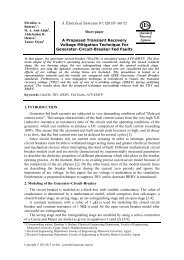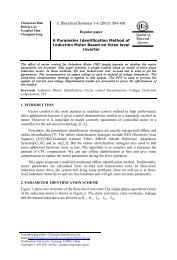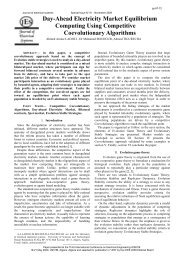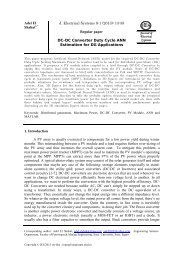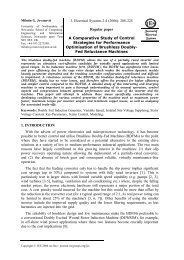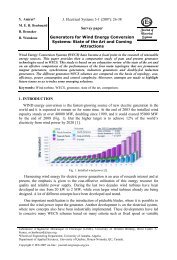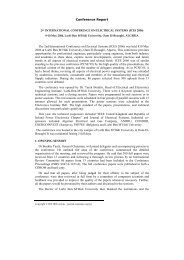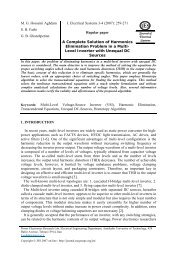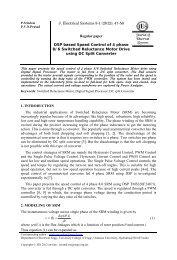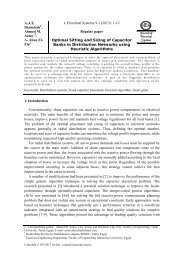Identification of Coherent Generators Using Fuzzy C-Means ...
Identification of Coherent Generators Using Fuzzy C-Means ...
Identification of Coherent Generators Using Fuzzy C-Means ...
You also want an ePaper? Increase the reach of your titles
YUMPU automatically turns print PDFs into web optimized ePapers that Google loves.
Mahdi M. M. El-ariniAhmed FathyJ. Electrical Systems 6-2 (2010): x-xxRegular paper<strong>Identification</strong> <strong>of</strong> <strong>Coherent</strong><strong>Generators</strong> <strong>Using</strong> <strong>Fuzzy</strong> C-<strong>Means</strong>Clustering Algorithm andConstruction <strong>of</strong> Dynamic Equivalent<strong>of</strong> Power SystemThis paper presents a new simple method to identify the coherent groups <strong>of</strong> generators based ontwo different techniques; the first one is based on six proposed coherency criterions introducedby using time response <strong>of</strong> the linearized power system model; the second one is based on theapplication <strong>of</strong> fuzzy c-means clustering algorithm (FCM). A new technique <strong>of</strong> constructing thedynamic equivalent <strong>of</strong> power system is also presented in this work. The results obtained by thefirst technique are compared to those obtained by FCM technique. The proposed method isapplied on 14-Bus IEEE power system. The obtained results proved that the proposed method ishighly effective in determining the coherent groups <strong>of</strong> generators and in constructing thedynamic equivalent <strong>of</strong> power system with high accuracy.Keywords: <strong>Coherent</strong> groups <strong>of</strong> generator, <strong>Fuzzy</strong> c-means clustering algorithm, Dynamic equivalents,Network reduction, Dynamic aggregation.1. Nomenclatureδ i (t) The rotor angels <strong>of</strong> i th generator∆δ i (t) The rotor angle deviation <strong>of</strong> machine i in PU∆ω i (t) The rotor speed deviation <strong>of</strong> machine i in PU∆P mi The change in mechanical input power <strong>of</strong> machine i in PUΔP ei The change in electrical output power <strong>of</strong> machine i in PUM i The inertia constant <strong>of</strong> machine i in PUD i The damping coefficient <strong>of</strong> machine i in PUE i The internal voltage <strong>of</strong> machine iG ij The transfer conductance between node i and jThe transfer susceptances between node i and jB ij'xdE fdThe D-axis transient reactance <strong>of</strong> machine iExciter output voltageK AK FV Sτ Aτ Fτ RV RV RmaxRegulator gainRegulator stabilizing circuit gainAuxiliary (stabilizing) input signalRegulator amplifier time constantRegulator stabilizing circuit time constantRegulator input filter time constantRegulator output voltageMaximum value <strong>of</strong> V RCorresponding author : Mahdi M. M. El-arini and Ahmed Fathy Elec. Power and M/C dept., Faculty <strong>of</strong>Engineering, Zagazig University, Zagazig, EgyptCopyright © JES 2010 on-line : journal.esrgroups.org/jes
V RminV REFT gG gU mISEδISEωIAEδIAEωMAEδMAEωε iSiaVeP meD eM eFCMJ mMinimum value <strong>of</strong> V RRegulator reference voltage settingThe governor time constant in secThe governor gainThe stabilizing signal <strong>of</strong> speed governor systemThe integral <strong>of</strong> the square <strong>of</strong> the rotor angle differenceThe integral <strong>of</strong> the square <strong>of</strong> the rotor speed differenceThe integral <strong>of</strong> the absolute magnitude <strong>of</strong> the rotor angle differenceThe integral <strong>of</strong> the absolute magnitude <strong>of</strong> the rotor speed differenceThe max <strong>of</strong> the absolute magnitude <strong>of</strong> the rotor angle differenceThe max <strong>of</strong> the absolute magnitude <strong>of</strong> the rotor angle differenceThe predetermined accuracy toleranceThe apparent power injection at the node iPhase shifting transformer complex turns ratioThe voltage <strong>of</strong> the equivalent busEquivalent machine input mechanical powerEquivalent machine damping coefficientEquivalent machine inertia constant<strong>Fuzzy</strong> c-<strong>Means</strong> clustersThe objective functionX data space <strong>of</strong> generator time-domain responses whose elements are {x j }C The number <strong>of</strong> clusters.n The number <strong>of</strong> generators.c i The center <strong>of</strong> cluster i.U The membership matrix whose elements are {μ ij }.μ ij The degree <strong>of</strong> relation <strong>of</strong> generator j to cluster i.m The exponent on μ ij , weighting coefficient.d ij The distance from xj to C i .2. IntroductionBecause modern power systems are so large, power system analysis programs do notusually model the complete system in detail [1]. This problem <strong>of</strong> modeling a large systemarises for a number <strong>of</strong> reasons including: Practical limitations on the size <strong>of</strong> computermemory, the excessive computing time required by large power systems; particularly whenrunning dynamic simulation and stability programs, parts <strong>of</strong> the system far away from adisturbance have little effect on the system dynamics and it is therefore unnecessary tomodel them with great accuracy, <strong>of</strong>ten parts <strong>of</strong> large interconnected systems belong todifferent utilities, each having its own control centre which treats the other parts <strong>of</strong> thesystem as external subsystems. The computational time can be reduced if the transientstability is determined in a reduced order equivalent model <strong>of</strong> the original system. Theoriginal system is divided into two systems or areas called the study system, and theexternal system. Fig. (1) illustrates such division.2
Fig. (1) Partition <strong>of</strong> the studied Power SystemsThe internal subsystem includes the disturbance and a small number <strong>of</strong> generators <strong>of</strong> greatconcern. These generators are severely disturbed and are in general responsible for thesystem instability. The rest <strong>of</strong> generators are considered in the external system. Thegenerators in the external system do not contribute significantly the system instability. Thusthe dynamic equivalencing technique is applied on these generators only. Power systemdivision is based on the generators close to fault have a tendency accelerate much fasterthan the generators away from the disturbance [7]. A coherent group <strong>of</strong> generating units, fora given disturbance, is a group <strong>of</strong> generators oscillating with the same angular speed andgenerator terminal busbar voltages in a constant complex ratio. A great deal <strong>of</strong> work hasbeen reported in the literature on determination <strong>of</strong> the coherent generators in powersystems. Reference [2] proposed the solution <strong>of</strong> linearized swing equations andidentification <strong>of</strong> machines swinging together through a clustering algorithm. Reference [3]used the linearized equation and split the power system into three circles and a patternrecognition approach based on the faulted machine acceleration is suggested. Reference [4]suggested a method <strong>of</strong> identifying coherent generators based on the generator inertias andsystem reduced admittance matrix obtained by eliminating the load buses. Reference [5]proposed a method <strong>of</strong> coherency identification technique based on equal acceleration andvelocity concepts. Reference [6] suggested a method for coherency identification, whichdoes not require the transient stability simulation <strong>of</strong> the system. The method based on usingsingular points or unstable equilibrium points (UEP) and admittance distance. Reference [7]proposed a method <strong>of</strong> determining the coherent generator groups in the external systemusing a combination <strong>of</strong> Taylor series expansion in three regions namely: (i) fault period, (ii)early part <strong>of</strong> the post fault period and (iii) later part <strong>of</strong> the post fault period. Reference [8]established the dynamic equivalent models <strong>of</strong> large-scale power systems based on the usage<strong>of</strong> phase shifting transformer. Reference [9] proposed a method <strong>of</strong> dynamic aggregationusing the complex power invariance principle. Paper [10] proposed The electromechanicalequivalent is formed by three steps; the first stage is the identification <strong>of</strong> the coherentgenerators based on the correlation between the linearized absolute-angle responses <strong>of</strong> allgenerators which is assumed as the ratio between the covariance between the rotor angledifferences between each pair <strong>of</strong> generators and the multiplication <strong>of</strong> standard division <strong>of</strong>each generator pair. Reference [11] suggested a method for dynamic reduction <strong>of</strong> powersystem based on significant and less-significant eignvalues. Paper [12] presented a reducedordermethod for swing mode eign value calculating based on fuzzy coherency recognition.Reference [13] presented the application <strong>of</strong> fuzzy c-means (FCM) clustering to therecognition <strong>of</strong> the coherent generators in power systems. This paper presents a new simplemethod to identify the coherent groups <strong>of</strong> generators based on two different techniques; thefirst one is based on six proposed coherency criterions introduced by using time response <strong>of</strong>the linearized power system model; the second one is based on the application <strong>of</strong> fuzzy c-means clustering algorithm (FCM). The obtained results proved that the proposed method is3
highly effective in determining the coherent groups <strong>of</strong> generators and in constructing thedynamic equivalent <strong>of</strong> power system with high accuracy.3. Mathematical ModelThe classical model is the simplest model used in studies <strong>of</strong> power system dynamics andrequires a minimum amount <strong>of</strong> data. This model is based on the following assumptions.1. Mechanical power input is constant.2. Damping or asynchronous power is negligible.3. Constant-voltage-behind-transient-reactance model for the synchronous machinesis valid.4. The mechanical rotor angle <strong>of</strong> a machine coincides with the angle <strong>of</strong> the voltagebehind the transient reactance.5. Loads are presented by passive impedances.The swing equation for machine number i can be described in a linearized form as follows:d ΔωiMi=ΔPmi −ΔPei − Diωi, i = 1,2,..., n (1)dtd Δδidt=Δ ω , i = 1,2,..., n(2)iThe power into the network at node i, which is the electrical power output <strong>of</strong> machine i , isgiven as follows:P = Re( E I )(3)i i in2ei=i ii+ ∑ i j ijcos( θij − δi + δj), = 1,2,...,j = 1j≠in2i ii i j ijδi δj ijδi δjj = 1j≠iP E G E E Y i n∑ (4)= E G + E E [ B sin( − ) + G cos( − )], i = 1,2,..., nThe set <strong>of</strong> equations (1) and (2) are sets <strong>of</strong> n-coupled nonlinear second-order differentialequations. It can be rearranged in state space model for n generators as follows:4
⎡ 1⎤⎢⎥⎡Δδ ⎤1⎡ 1⎤⎡Δδ1 ⎤ ⎢⎥⎢ ⎥ ⎢ ⎥⎢δ⎥Δ ⎢ ⎥⎢ δ2⎥ ⎢ ⎥⎢Δ2⎥ ⎢⎥1⎢ ⎥ ⎢ 0 ⎥⎢ ⎥ ⎢⎥⎢ ⎥ ⎢ ⎥⎢ ⎥ ⎢ ⎥Δ ⎢ δ1 δn ⎥ ⎢ ⎥⎢Δn ⎥ ⎢⎥⎢ ⎥ ⎢ ⎥⎢ ⎥1 = + ⎢ ⎥[ Δ Pm 1 Δ Pm2 Δ Pn⎢ ⎥ ⎢ ⎥⎢ ⎥ ⎢]M⎥1⎢Δ ω K1⎥ ⎢ 11 K1 n D1 ⎥⎢Δω1 ⎥ ⎢⎥⎢Δ ω⎥ ⎢K 2 21 K2 n D ⎥⎢2Δω⎥ ⎢ 1 ⎥2⎢ ⎥ ⎢ ⎥⎢ ⎥ ⎢ M ⎥2⎢ ⎥ ⎢ ⎥⎢ ⎥ ⎢⎥⎢ ⎥Δω⎢Kn n1Knn D⎥⎢nΔω⎥ ⎢ ⎥⎣ ⎦ ⎣ ⎦⎣ n⎦⎢1⎥⎢⎥⎢⎣Mn⎥⎦(5.a) (5.b)Or X = AX + BUTWhere X = [ Δδ1, Δδ2,..., Δδn, Δω1, Δω2,..., Δ ωn] , U = [ ΔPm1, ΔPm2,..., Δ Pmn]and the diagonal and <strong>of</strong>f-diagonal elements K ii , K ij are as follows:1 ∂ΔPeiKij= − i ≠ jM ∂ΔδKiiij1=− [ EEYi j ij sin( δi −δ j− θij)] (6)Mi1 ∂ΔPei=−M ∂Δδii∑ i j ik i k ik(7)k = 1k ≠in1=− [ [ EEY sin( δ −δ −θ)]]MiA static reduction is performed on the original power system in order to obtain thegenerator nodes only. This reduction is obtained by the following expression.red1Y ( YmmYmrY −rrYrm)= − (8)Where subscript m denotes the generating bus and r denotes the load bus. The busredadmittance matrix used in eqn. (6) and eqn. (7) is Y as model is used after staticreduction <strong>of</strong> power system. It is important view to represent the synchronous machine inhigh order state space model taking in consideration the modeling <strong>of</strong> excitation system andthe modeling <strong>of</strong> speed-governor system. The excitation system that is used is IEEE Type -1system which is shown in Fig. (2).Fig. (2) IEEE Type one excitation system5
From Fig. (2) One can write the matrix form <strong>of</strong> the excitation system as follows:⎡ 1⎤ ⎡ K ⎤R⎢ − 0 0 ⎥ ⎢ Vt ⎥τRτR⎡V⎤ ⎢ ⎥1 ⎡V1⎤ ⎢ ⎥⎢ KKF A( KKF A A)KF KKF AV⎥ ⎢ + τ ⎥⎢ 3V⎥ ⎢ ⎥⎢ ⎥=− ⎢ − ⎥ 3( VREFVS)ττF AττF Aττ ⎢ ⎥+ ⎢ + ⎥F AττF A⎢E⎥ ⎢ ⎥FDE ⎢ ⎥⎣ ⎦⎢ ⎥FD⎢ KA KA 1 ⎥⎣⎦ ⎢ K ⎥A⎢ − − − ⎥ ⎢ ( VREF+ VS) ⎥⎣ τR τR τR ⎦ ⎣ τA⎦(9)On the other side, by the simplified model <strong>of</strong> the speed governor transfer function is givenas follows:UmPm1=Gg 1 + ST− ( ) S δωoWhere T g is the governor time constant in sec, G g is the governor gain; P m is the inputmechanical power and U m is the stabilizing signal <strong>of</strong> speed governor system. Finally; thelinearized form <strong>of</strong> eqn. (10) is:1 Gg 1Δ P m= ( ) Um−( ) Δω−( ) ΔPm(11)Tg Tgωo TgFrom eqns. 1, 2, 9 and 11, one can get the overall model <strong>of</strong> one generation unit(synchronous machine, exciter and speed governor) as follows:X = AX + BU(12)Where X =Δ [ δ , Δω, ΔV1, ΔV3, ΔEFD , Δ Pm ], andu = [ Vs , um] , on the other sidefor multi machines system one can get the overall state space model as in eqn. (12) with thefollowing definition:XT= [ x1, x2,..., x6] , x1= [ Δδ1, Δδ 2,..., Δ δn], x2=[ Δω1, Δω 2,..., Δ ωn], x3= [ ΔV 11, ΔV 12,..., ΔV1n],x4= [ ΔV 31, ΔV 32,..., Δ V3n ], x5= [ ΔE FD 1, ΔE FD 2,..., ΔEFDn],x6= [ ΔPm 1, ΔPm 2,..., ΔPmn],BuKR 1KRnKF 1KA 1= [0 : 0 : Vt1,..., Vtn: ( VREFτR 1τRnτF 1τA 1+ Vs),...,KFnKA nKA 1KA n( VREF+ Vs) : ( VREF+ Vs),...,τFnτ A nτA 1τA n1 1TΔPm1,..., ΔPmn]TT( VREF+ Vs) :g 1gng(10)6
4. Proposed TechniqueIn this section the proposed two different techniques <strong>of</strong> the identification <strong>of</strong> the coherentgenerators, the dynamic aggregation and the calculation <strong>of</strong> the new transmission lines arepresented.4.1 The First Proposed Technique for coherency identificationIn this section; the first proposed technique <strong>of</strong> the identification <strong>of</strong> the coherent generatorsis described. The proposed coherency algorithm is based on six proposed coherencycriterions as follows:1) ISEδ: the integral <strong>of</strong> the square <strong>of</strong> the rotor angle difference.1 TS1= ( ( Δδ() ())0it −Δδjt dtT∫(13)2) ISEω: the integral <strong>of</strong> the square <strong>of</strong> the rotor speed difference.1 TS2= ( ( Δω() ())0it −Δωjt dtT∫(14)3) IAEδ: the integral <strong>of</strong> the absolute magnitude <strong>of</strong> the rotor angle difference.T1S3= Δδi() t −Δδj()t dtT∫(15)04) IAEω: the integral <strong>of</strong> the absolute magnitude <strong>of</strong> the rotor speed difference.T1S4= Δωi() t −Δωj()t dtT∫(16)05) MAEδ: the max <strong>of</strong> the absolute magnitude <strong>of</strong> the rotor angle difference.S5 = max Δδi( t) −Δ δi( t)(17)6) MAEω: the max <strong>of</strong> the absolute magnitude <strong>of</strong> the rotor angle difference.S6 = max Δωi( t) −Δ ωi( t)(18)The obtained values <strong>of</strong> the coherency index (S i , i=1, 2,…, 6) are arranged in an ascendingorder. A generator pair (i, j) in the external system is said to be coherent if they satisfied thefollowing condition:Si≤ εi, i = 1,2,...,6(19)Where ε i is a predetermined accuracy tolerance for each proposed coherency criterion.4.2 The second Proposed Technique for coherency identificationIn this section; the proposed method <strong>of</strong> identification <strong>of</strong> coherent groups <strong>of</strong> generators usingFCM is described. FCM is a method <strong>of</strong> clustering which allows one piece <strong>of</strong> data to belongto two or more clusters. This method (developed by Dunn in 1973 and improved by Bezdekin 1981) is frequently used in pattern recognition. FCM algorithm [14] uses concepts <strong>of</strong> n-dimensional Euclidean space to determine the geometric closeness <strong>of</strong> data points byassigning them to various clusters and then determining the distance between the clusters.The distance between points in the same cluster will be considerably less than the distancebetween points in different clusters. The most widely used objective function for fuzzyclustering is the weighted sum <strong>of</strong> the squared errors within groups. The objective functionJ m can be defined as:7
c nm 2m( ,i, ) μij iji = 1 j=1J U C X d= ∑∑ (20)First; the coherency measures are derived from ISEδ and ISEω to reveal the relationsbetween any pair <strong>of</strong> generators then; finally; they are used as the initial membership matrixin the FCM clustering.. The obtained results by each C ij are compared. The index is furthernormalized to become:SijS ′ij= (21)max( S )Finally, the coherency measure is obtained byijCij= 1− S′ij(22)Obviously, 0≤C ij ≤1and C ii =1and C ij =C ji The association between the pair <strong>of</strong> generators andcan be evaluated by the value <strong>of</strong> C ij . A larger indicates that generator i and generator j aremore similar in the time domain. The clustering procedures <strong>of</strong> using the coherencymeasures as initial values in FCM method can be formulated as shown in Fig. (3).4.3 Proposed Dynamic AggregationAfter the coherent groups <strong>of</strong> generators are identified, the generators in each group can beaggregated to an equivalent generator, the construction <strong>of</strong> the dynamic equivalent reducedcircuit, as the coherent generators are replaced by one equivalent generator. The proposedform to calculate the mechanical power, inertia constant and damping coefficient are asfollows:PmeMem= ∑ P(23)=i = 1m∑i = 1m∑miSMSiTSDi ii = 1De=(25)STWhere S i is the MVA <strong>of</strong> machine no. i and S T is the total MVA <strong>of</strong> coherent machines.4.4 Determination <strong>of</strong> Equivalent Transmission NetworkIn this section, there are a proposed form to calculate the new transmission lines parameterswhich is based on the apparent power injected at the equivalent bus must be equal to thesum <strong>of</strong> the powers injected at the aggregated bus <strong>of</strong> the coherent generators and using anideal transformer with complex turns ratio to the equivalent bus at each terminal bus <strong>of</strong> thecoherent generator. The turn’s ratio <strong>of</strong> the ideal transformer is given by:aiVi(24)i= (26)VeWhere Veis the voltage <strong>of</strong> the equivalent bus. The final form <strong>of</strong> the proposed symmetricalaggregated reduced bus admittance matrix is shown in eqn. (27):8
Input the coherencymeasure C ij tolerance εConstruct (n×n) fuzzy relation matrix R, R=[C ij ],0≤Cij≤1, i=1,….,n, j=1,….,n n:number <strong>of</strong> generatorsSelect the number <strong>of</strong> clusters (c), set the initial samplinginstant t k and set iteration count l=1Initialize the (c×n) membership matrix U U (l) =[Cij] i=1,…., c, j=1,…., nDetermine the time response value <strong>of</strong> generator j {x j } at thecorresponding sample instantCalculate the cluster center C i(l)Compute the distance between generator j and cluster center Il=l+1Update the membership matrix byNoYesSelect the next sampling instantNoIs t k =t finalYesDefuzzify the convergent U <strong>of</strong> the final sampling instantEndFig. (3) Flow chart <strong>of</strong> the fuzzy C-<strong>Means</strong> clustering9
* T* T⎡ a Ymma a Y⎢⎢ ⎢* T T⎣( a Ymmt) YWhere subscript m denotes the coherent generators and subscript m t denotes the totalgenerators.5. Numerical AnalysisIn this section, the proposed method is applied on 14-Bus, 5 Machine IEEE System powersystem. The single line diagram <strong>of</strong> the IEEE 14-bus standard system is shown in Fig. (4). Itconsists <strong>of</strong> five synchronous machinesmtmtmmt⎤⎥⎥⎥⎦(27)Fig. (4) The single line diagram <strong>of</strong> 14-Bus IEEE systemAssume that an open circuit occurs at bus 4. Table (1) shows the calculated s i , i=1,…,6. Fig.(5) and Fig. (6) show the time responses <strong>of</strong> all generators during the fault. Assuming thevalues <strong>of</strong> error levels as a percentage <strong>of</strong> the maximum values <strong>of</strong> the proposed coherencycriterions as ε 1 =0.3 rad, ε 2 = 0.04 rad/sec, ε 3 =0.3 rad, ε 4 =0.02 rad/sec, ε 5 =0.4 rad and ε 6 =0.2rad/sec.; one can get that the coherent generators are G 1 , G 2 and G 3 .Fig. (5) The response <strong>of</strong> 14-Bus IEEE system after removing the bus no. 4 from the originalsystem10
Ranking<strong>of</strong> S 1Table (1) the ascending rank <strong>of</strong> the coherency criterionsRanking<strong>of</strong> S 2Ranking<strong>of</strong> S 3Ranking<strong>of</strong> S 4Ranking <strong>of</strong>S 5Ranking<strong>of</strong> S 6S 2-3 0.1003 S 1-2 0.0143 S 2-3 0.0971 S 1-2 0.005 S 2-3 0.221 S 2-3 0.0894S 1-2 0.269 S 2-3 0.0164 S 1-2 0.2668 S 2-3 0.006 S 1-2 0.319 S 1-2 0.0966S 1-3 0.3678 S 1-3 0.0273 S 1-3 0.3639 S 1-3 0.01 S 1-3 0.516 S 1-3 0.1607S 4-5 1.2371 S 4-5 0.0654 S 4-5 1.2114 S 4-5 0.022 S 4-5 1.82 S 4-5 0.3741S 3-4 2.4897 S 3-4 0.1069 S 3-4 2.4513 S 2-4 0.038 S 3-4 3.489 S 3-4 0.4785S 2-4 2.5857 S 2-4 0.1081 S 2-4 2.5484 S 3-4 0.039 S 2-4 3.502 S 2-4 0.5479S 1-4 2.8536 S 1-4 0.1161 S 1-4 2.8152 S 1-4 0.04 S 1-4 3.791 S 1-4 0.5875S 3-5 3.7261 S 2-5 0.1677 S 3-5 3.6627 S 2-5 0.059 S 3-5 5.309 S 2-5 0.8182S 2-5 3.8217 S 3-5 0.1684 S 2-5 3.7598 S 3-5 0.06 S 2-5 5.315 S 1-5 0.8503S 1-5 4.0893 S 1-5 0.1741 S 1-5 4.0266 S 1-5 0.061 S 1-5 5.566 S 3-5 0.8526Fig. (6) The rotor angle deviation differences <strong>of</strong> 14-Bus system after removing bus no. 4The original system has 14 nodes and 5 generators; while the reduced system has 3generators only one <strong>of</strong> them is the equivalent machine <strong>of</strong> coherent generators, G 4 and G 5and 3 nodes. Table (2) shows the first proposed coherency measures that represent ISEδwhich are derived from the time-domain response <strong>of</strong> generators for that disturbance. Theselected sample period is 1.3 sec, assuming that the convergent tolerance is given as ε=0.01 and the maximal iterative times is 100. The elements <strong>of</strong> convergent membershipmatrix at the final sampling instant <strong>of</strong> the 3-cluster scheme are sown in Table (3).11
Table (2) the first proposed coherency measures between generators <strong>of</strong> 14-Bus system∆δ 1 ∆δ 2 ∆δ 3 ∆δ 4 ∆δ 5∆δ 1 1 0.9342 0.9101 0.3022 0∆δ 2 0.9342 1 0.9755 0.3677 0.0654∆δ 3 0.9101 0.9755 1 0.3912 0.0888∆δ 4 0.3022 0.3677 0.3912 1 0.6975∆δ 5 0 0.0654 0.0888 0.6975 1Table (3) The Elements <strong>of</strong> convergent membership matrix at the final sampling instant <strong>of</strong>the 3-cluster scheme for 14-Bus system due to ISEδG 1 G 2 G 3 G 4 G 5Cluster 1 0.0094 0.0007 0.0078 1.0000 0.0000Cluster 2 0.0041 0.0003 0.0030 0.0000 1.0000Cluster3 0.9864 0.9990 0.9892 0.0000 0.0000In the cluster group 3, the elements <strong>of</strong> G 1 , G 2 and G 3 are, respectively, 0.9864, 0.9990and0.9892, and are very close to 1, which proves that they form this cluster. From Table (3)one can derive that there are three cluster groups: Cluster group 1 contains G 4 . Clustergroup 2 contains G 5 . Cluster group 3 contains G 1 , G 2 and G 3 . Table (4) shows the secondproposed coherency measures that represent ISEω.Table (4) the second proposed coherency measures between generators <strong>of</strong> 14-Bus system∆ω 1 ∆ω 2 ∆ω 3 ∆ω 4 ∆ω 5∆ω 1 1 0.9179 0.8432 0.3331 0∆ω 2 0.9179 1 0.9058 0.3791 0.0368∆ω 3 0.8432 0.9058 1 0.3860 0.0327∆ω 4 0.3331 0.3791 0.3860 1 0.6244∆ω 5 0 0.0368 0.0327 0.6244 1The elements <strong>of</strong> convergent membership matrix at the final sampling instant <strong>of</strong> the 3-clusterscheme are sown in Table (5).Table (5) The Elements <strong>of</strong> convergent membership matrix at the final sampling instant <strong>of</strong>the 3-cluster scheme for 14-Bus system due to ISE ωG 1 G 2 G 3 G 4 G 5Cluster 1 0.010855 0.00080401 0.0092877 1 9.2977e-9Cluster 2 0.98443 0.99888 0.98724 4.4448e-8 1.2494e-9Cluster 3 0.0047113 0.00031601 0.0034753 1.329e-7 1From Table (5) one can derive that there are three cluster groups: Cluster Group 1 containsG 4 . Cluster Group 2 contains G 1 , G 2 and G 3 . Cluster Group 5 contains G 5 . It is derived thatthe obtained results for using ISEω as the coherency measures is the same for using ISEδ asthe coherency measures. Fig. (7) show the clusters group’s centers and the membershipmatrix for each iteration. It is clear that the results obtained by the proposed FCM algorithmare the same results obtained by the first proposed technique. Table (6) shows the12
parameters <strong>of</strong> the equivalent machine and the bus admittance matrix <strong>of</strong> system afteraggregation.Fig. (7) The cluster groups centers and membership matrix for 14-Bus IEEE system three clustersalgorithmTable (6) the parameters <strong>of</strong> the equivalent machineTheinertiaconstantM eq(Sec)54.2637ThedampingcoefficientD eq (pu)10.4878Thetransientreactancex de (pu)0.4165Themechanicalpower P me(pu)14.1819ThearmatureresistanceR a (pu)0.0003The aggregated busadmittance matrix(pu)Y e-e =2.7439-7.1105iY e-4 =0.0141+0.7316i,Y e-5 =0, Y 4-4 =1.1235-5.7276i, Y 4-5 =-0.1972+ 0.8054i andY 5-5 =0.1220 - 3.3360iThe effect <strong>of</strong> system modeling, system parameters and system loading conditions is studied.When a symmetrical three-phase short circuit fault occurs at bus number 3 and cleared byopening line (3-4) after 5- cycles (0.1 sec); it is found that the coherent generators are: G 2 ,G 4 and G 5 . When the high order system (each machine has six states which are ∆δ, ∆ω, ∆V 1,∆V 3, ∆E fd and ∆P m ) are the same for the low order model <strong>of</strong> the generator (each machine hastwo states which are ∆δ and ∆ω). Fig. (8) show the speed <strong>of</strong> G 1 in the low-order model andin the high order model. The effect <strong>of</strong> system parameters can be divided to the effect <strong>of</strong>changing the inertia constant, transient reactance and damping coefficient on the coherentgenerators. The effect <strong>of</strong> changing the inertia constant is shown in Table (7) and Fig. (9). Itis derived that the changing <strong>of</strong> inertia constant has a small effect on changing the coherentgenerators. The effect <strong>of</strong> changing the machines damping coefficients is shown in Table (8)and Fig. (10). From Table (8) it is derived that when the damping coefficient is increasedthe coherent generators are changed from those obtained in the base case.13
Fig. (8) The speed <strong>of</strong> generator No. 1 in the low order model and in the high order modelTable (7) The effect <strong>of</strong> Changing the inertia constant on 14-Bus system<strong>Coherent</strong><strong>Generators</strong>Parameters <strong>of</strong> the equivalent machineM eq(pu)K deq (pu)P meq(pu)X d’(pu)Decreasing by80%G 2 , G 4 and G 5 0.5712 0.4495 -10.0741 0.5629Decreasing by66.7%G 2 , G 4 and G 5 0.9520 0.4495 -10.0741 0.5629Base Case G 2 , G 4 and G 5 2.8559 0.4495 -10.0741 0.5629Increasing by200%G 2 , G 4 and G 5 8.5678 0.4495 -10.0741 0.5629Increasing by400%G 2 , G 4 and G 5 14.2797 0.4495 -10.0741 0.562914Fig. (9) The effect <strong>of</strong> changing the machines inertia constants on the speed <strong>of</strong>generator No. 4
Table (8) The effect <strong>of</strong> Changing the damping coefficient on 14-Bus systemDecreasing by80%Decreasing by66.7%<strong>Coherent</strong><strong>Generators</strong>M eq(pu)Parameters <strong>of</strong> equivalent machineK deq(pu)P meq(pu)X d’(pu)G 2 , G 4 and G 5 2.8559 0.0899 -10.0741 0.5629G 2 , G 4 and G 5 2.8559 0.1498 -10.0741 0.5629Base Case G 2 , G 4 and G 5 2.8559 0.4495 -10.0741 0.5629Increasing by200%Increasing by400%G 1 , G 2 , G 4 andG 53.30769 1.92708 6.0267 0.4138G 1 , G 2 , G 4 andG 53.30769 3.21180 6.0267 0.4138The third term is the transient reactance’s <strong>of</strong> generators; Table (9) and Fig. (11) show theeffect <strong>of</strong> changing the machines transient reactance’s on the coherent generators. FromTable (9); one can derive that the change <strong>of</strong> the machines transient reactance's has a largeeffect on the coherent generators. Finally; the effect <strong>of</strong> loading conditions are studied. Thefirst technique is changing the load active power and assuming constant reactive power.Table (10) and Fig. (12) show the coherent generators at varying load active power. FromTable (10) one can derive that; by decreasing the load active power the coherent generatorsare changed from those obtained in the base case.Table (9) The effect <strong>of</strong> Changing the transient reactance on 14-Bus systemDecreasing by80%Decreasing by66.7%<strong>Coherent</strong><strong>Generators</strong>M eq(pu)Parameters <strong>of</strong> equivalent machineK deq (pu)P meq(pu)X d’(pu)G 1 , G 2 , G 4 andG 53.307693 0.64236 6.9267 0.0828G 1 , G 2 , G 4 andG 53.307693 0.64236 6.0267 0.1379Base Case G 2 , G 4 and G 5 2.8559 0.4495 -10.0741 0.5629Increasing by200%G 4 and G 5 0.6325 0.1250 -3.8066 1.4917Increasing by400%G 4 and G 5 0.6325 0.1250 -5.0983 2.486215
Table (10) The effect <strong>of</strong> Changing the load active power on 14-Bus systemDecreasingby 80%Decreasingby 66.7%<strong>Coherent</strong><strong>Generators</strong>M eq(pu)Parameters <strong>of</strong> equivalent machineK deq(pu)P meq(pu)X d’(pu)G 1 , G 2 , G 4 andG 53.307693 0.64236 6.5378 0.4138G 1 , G 2 , G 4 andG 53.307693 0.64236 6.0267 0.4138Base Case G 2 , G 4 and G 5 2.8559 0.4495 -10.0741 0.5629Increasingby 150%Increasingby 200%G 2 , G 4 and G 5 2.8559 0.4495 -14.6530 0.5629G 2 , G 4 and G 5 2.8559 0.4495 -16.7850 0.5629Fig. (10) The effect <strong>of</strong> changing the transient reactance’s on the speed <strong>of</strong>generator No. 4 for 14-Bus IEEE system16Fig. (11) The effect <strong>of</strong> changing load active power on the speed <strong>of</strong>generator No. 2 for 14-Bus IEEE system
The second technique is changing the load reactive power and assuming constant activepower. Table (11) and Fig. (13) show the coherent generators at varying load reactivepower.Decreasingby 80%Decreasingby 66.7%Table (11) Effect <strong>of</strong> Changing the reactive power on 14-Bus system<strong>Coherent</strong><strong>Generators</strong>M eq(pu)Parameters <strong>of</strong> equivalent machineK deq (pu)P meq(pu)X d’(pu)G 1 , G 2 , G 4 andG 53.3076933 0.64236 6.0346 0.4138G 1 , G 2 , G 4 andG 53.307693 0.64236 6.0346 0.4138Base Case G 2 , G 4 and G 5 2.8559 0.4495 -10.0741 0.5629Increasingby 150% G 2, G 4 and G 5 2.8559 0.4495 -21.4744 0.5629Increasingby 200% G 2, G 4 and G 5 2.8559 0.4495 -21.4410 0.5629Fig. (12) The effect <strong>of</strong> changing load reactive power on the speed <strong>of</strong>generator No. 2 for 14-Bus IEEE systemFrom Table (11) it is derived that the changing the load reactive power on the coherentgenerators; has the same effect <strong>of</strong> changing the load active power.6. ConclusionThis paper presents a new simple and an accurate method <strong>of</strong> identifying the coherentgroups <strong>of</strong> generators based on two different proposed techniques; the first one is based onsix proposed coherency criterions introduced by using time response <strong>of</strong> the linearizedpower system model; the second one is based on the application <strong>of</strong> fuzzy c-meansclustering (FCM). The FCM clustering approach is used for processing the computed17
coherency measures and the clustering <strong>of</strong> generator groups at different prescribed number<strong>of</strong> coherent groups can be obtained. Also a new proposed algorithm <strong>of</strong> constructing thedynamic equivalent <strong>of</strong> power system is presented in this work. The calculations <strong>of</strong> theparameters <strong>of</strong> the new transmission lines are also presented. The effect <strong>of</strong> systemparameters, modeling and loading conditions are also studied. It is found that the changing<strong>of</strong> machines inertia constants and machines modeling have a small effect on the coherentgenerators, while The machines damping coefficients, transient reactance’s and loadingconditions have a large effect on the coherent generators.The obtained results show that the coherent groups <strong>of</strong> generators are dependent on the typeand the location <strong>of</strong> disturbance. The proposed method is highly effective in determining thecoherent groups <strong>of</strong> generators and in constructing the dynamic equivalent <strong>of</strong> power system.7. References[1] R. JAMES, W. JANUSZ and JARR MACH.: “Power System Dynamics and Stability”, JOHNWILEY and SONS LTD., 1997.[2] PODMORE, R.: '<strong>Identification</strong> <strong>of</strong> <strong>Coherent</strong> <strong>Generators</strong> for Dynamic Equivalents', IEEE Trans.,1978, PAS-97, (4), PP. 1344-1354.[3] LEE, S.T.Y., and SCHWEPPE, F.C.: 'Distance Measure and Coherency Recognition for TransientStability equivalents', IEEE Trans., 1973, PAS-92, PP. 1550-1557.[4] KRISHAPARANDHAMA, S. ELANGORAN and K. Kuppurajulu, 'Method for Identifying<strong>Coherent</strong> <strong>Generators</strong>', Vol. 3, No. 2, PP. 85-90, April 1981.[5] M. Y. HUSSAIN, V.G. RAU. :'Coherency <strong>Identification</strong> and Construction <strong>of</strong> Dynamic Equivalentfor Large Power System', IEE 2nd International Conference on Advances in Power System Control.Operation and Management. December 1993. Hong Kong.[6] SPALDING, B.D., YEE, H., and GOUDIE, B.D.: ‘Coherency Recognition for Transient StabilityStudies <strong>Using</strong> Singular Points’, IEEE Trans., 1977, PAS-96, (4), pp. 1368-1375.[7] MIR MUJAHID ALI, '<strong>Identification</strong> <strong>of</strong> <strong>Coherent</strong> <strong>Generators</strong> <strong>Using</strong> Linear Trajectory', Msc. D.Thesis, University <strong>of</strong> Ng Fahd <strong>of</strong> Petroleum and Minerals, Dhahrann, Saudi Arabia, 1993.[8] J. P. YANG, G. H. CHENG, Z. XU. :'Dynamic Reduction <strong>of</strong> Large Power System in PSS/E',IEEE/PES Transmission and Distribution Conference & Exhibition, 2005: Asia and Pacific Dalian,China.[9] GHAFURIAN. A. and BERG. G. J. Coherency Based Multimachine Study', IEE PROC., Vol.129, Pt. C, (4), July 1982, PP. 153-160.[10] MOHAMED EL-SHIMY, 'Electromechanical System Equivalent and Dynamic LoadAggregation for Transient Stability <strong>of</strong> Electric Power System', Ph. D. Thesis, University <strong>of</strong> AinShams, Cairo, 2004.[11] Mahdi M. M. El-Arini, M. M. El Metwally,’Order Reduction in Dynamic Modeling <strong>of</strong> PowerSystem Control’, Engineering First Intern. Conference, Cairo, Egypt, December 9-12, 1989, Vol. 8,PP. 207-218.[12] ZHAO SHUQIANG, XIANRONG, YANJIANG and RENMU, ‘A Reduced Order Method forSwing Mode Eignvalue Calculating Based on <strong>Fuzzy</strong> Coherency Recognition’, Power systemTechnology Proceedings 1998. Vol. 2, pp 1402-1405.[13] SHU-CHEN WANG and PEI-HWA HUANG, ’<strong>Fuzzy</strong> C-<strong>Means</strong> Clustering for Power SystemCoherency’, IEEE international conference 2005, Vol. 3, pp. 2850-2855.[14] N. Pal, K. Pal, J. Keller, and J. Bezdek, ‘A possibilistic fuzzy c-means clustering algorithm’,IEEE Trans <strong>Fuzzy</strong> Systems, Vol. 13, No. 4, 2005, pp. 517–530.[15] A. K. BEHERA, 'Transient Stability Analysis <strong>of</strong> Multimachine Power System <strong>Using</strong> DetailedMachine Models', Ph. D. Thesis, University <strong>of</strong> Illinois at Urbana-Champaign, 1988.18




